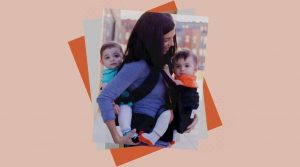Babywearing not only fosters that important early bonding but also makes life a lot easier for parents. It allows you to free up your hands so your baby is protected and feels close to you while you go about your day-to-day.
But wait — understandably, there are so many babywearing options available to parents and caregivers that it may give you pause.
To help you with your deep dive, we’ve compiled this expert, easy to understand, guide to babywearing options. You’ll soon have a better idea of what’s best for you and your baby.
In this article:
Side by side comparison
| Carrier | Wrap | Ring sling | |
|---|---|---|---|
| Safety: How secure is this carrier? | 5 (out of 5) | 4 | 4 |
| Comfort: Is it comfortable for wearer and baby? | 4 | 4 | 4 |
| Versatility: Is it usable in many positions? Is it shareable? | 5 | 5 | 4 |
| Cost: Is it budget friendly? | 2 | 4 | 5 |
| Ease of Use: Is it simple to learn? | 4 | 2 | 4 |
| Washability: Is it easy to wash and dry it? | 3 | 5 | 5 |
Soft-structured carriers
These are such popular carriers that it’s near impossible to go out without spotting a baby or toddler happily bouncing along in one.
They function just as their name suggests, with a soft structure that enables the carrier to protect the baby and remain comfortable for the wearer.
No tying or preparing is required with this pick, which fastens with buckles around the wearer’s waist and back.
Soft-structured carriers are, as we established, very common. The market is flooded with picks, some of which are pricey.
Beware of lower-end models from unknown brands, as it’s essential that soft-structured carriers be hip-healthy for a baby, meaning that babies can sit with their legs in a natural ‘M’ formation.
Carriers that don’t allow this are detrimental to your baby’s long-term skeletal health, so should not be considered.
Carrying positions: Front-inward facing, front-outward facing, hip carry, back carry
Pros
- Easy to put on, some models adjust easily to different-sized wearers
- Some have unique features, like pockets and privacy panels, that make life on the go easier for baby wearers
- It’s a versatile pick, meaning it lets wearers safely carry baby in a number of different positions
Cons
- Soft-structured carriers are, typically, the most expensive baby wearing carrier, because they’re the most complex and featured
- They’re bulkier than other baby wearing carriers, which means that storing, washing and drying them can be a lengthy process
- Not all are suitable for newborns without an infant insert, which is usually sold separately and can be costly
Related: Ergobaby vs Baby Björn (2021 Comparison Guide)
Wraps
Throughout history, mothers have fashioned wraps to carry their babies, but updated versions of these clever cloth panels look a bit more glamorous!
They’re generally soft and comfortable, while many picks are designed to be washable and forgiving of the inevitable mess created by babies and toddlers.
The cut of the fabric is also designed to make wrapping baby simple, and the Internet is packed with tutorials that make it look like a breeze.
That said, there’s still a learning curve to wraps. Stretchy wraps can be good picks for new parents, as they’re comfortable and can be tied without a baby for ease and safety.
They’re much easier than woven wraps, though less safe and comfortable as the baby grows.
Woven wraps are slightly more difficult to learn, but once you master them, they’re extremely safe and comfortable and have great carrying versatility.
Carrying positions (woven wraps only): There are tons! Check some out here.
Pros
- Stretchy wraps are easy to tie, budget-friendly and an ideal pick for newborns
- Woven wraps are lightweight and offer a variety of safe, hip-healthy carrying positions for wearers
- It’s a less bulky carrier style, so it’s easy to stash in a diaper bag and requires less air-drying time when washed
Cons
- Stretchy wraps are only truly safe for newborn carrying, plus they can get uncomfortable as baby grows
- Woven wraps are bought by size, so two different-sized parents would struggle to share one
- Learning to wrap correctly and safely takes time and patience
Related: Baby K’tan vs Moby Wrap (2021 Comparison Guide)
Ring slings
Fashionable and fun, ring slings operate on a similar premise to wraps, but are a bit easier to use. They make use of a sturdy, safe metal or wooden ring that makes tying the wrap for wear a bit easier.
Like wraps, there are lots of different styles, colors, and fabrics available, some of which are designed to be both comfortable and washable.
Even though they’re a bit easier than traditional wraps, there’s a learning curve to ring slings, so take advantage of the many tutorial videos available online that make the process easier to learn.
Learning the right position is important for both safety and comfort reasons. It’s important to know that ring slings aren’t great if you have chronic back or shoulder pain, as this can make carrying uncomfortable and exacerbate the issue.
Carrying positions: front carry, hip carry, back carry
Pros
- Similarly to a wrap, but easier to execute
- Available in many styles and colors, but also easy to assemble from scratch if you want
- Not bulky, so stores easily and air dries quickly (make sure you keep it flat so it holds its shape).
Cons
- Not a great pick if you have chronic back or shoulder pain
- They’re generally sized, so sharing can be hard and unsafe
- The position of the ring is key because, in the wrong place, it will be uncomfortable for the wearer
Related: The Best Ring Slings You Can Buy in 2021
Key takeaways
Soft-Structured Carriers
- Offers safe, versatile carrying positions for baby
- Fastens with buckles, adjusts for wearer
- Good picks are pricier than wraps or ring slings
- Bulkier and more difficult to clean than wraps or ring slings
Wraps
- Available in a variety of colors and fabrics
- Cheaper than soft-structured carriers, but offer a similar versatility of carrying positions
- More complex to learn than soft-structured carriers or ring slings
- Unadjustable, so size sharing can be difficult
Ring slings
- As with wraps, available in a variety of colors and fabrics
- Easier to put on than a wrap, though not quite as simple as a soft-structured carrier
- Offers three carrying positions, better for younger babies
- Unsuitable for wearers with chronic back or shoulder pain
Related: Tula Ergonomic vs. Lillebaby All Seasons (2021 Comparison Guide)
There’s a lot to love about babywearing, and one of the big pros is the number of options available.
Whether you love the breeziness of fabric wraps and slings or feel more comfortable with the security and features of a soft-structured carrier, you and your baby can bond while you’re out there getting it done.
Now that we’ve answered the big questions, you could be well on your way to making a great pick for you and your baby.








